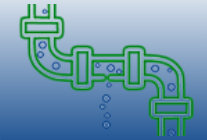Corrosion Control

The vast majority of water services in buildings utilise metal pipes or have metallic components in their construction. The in-service replacement of failed metallic components is usually very expensive and highly inconvenient for the user. In addition to the obvious and permanent damage that corrosion can cause, it should be noted that elevated levels of metals in water, may be harmful to health, give rise to operational problems and can provide nutrients for bacteria such as legionella. For these reasons it is imperative that corrosion control be given due consideration at the design stage.
Corrosion of systems can arise for many reasons, it is complex and not simple to diagnose pro-actively. Causes of corrosion though include (but not limited to):
- Poor care during construction and commissioning
- Water chemistry
- Microbiologically induced corrosion
- Galvanic / electrochemical corrosion
- Pitting corrosion
- Erosion corrosion
- Particulate induced corrosion
- Under deposit corrosion
- Flux induced corrosion
There are however several measures that can be taken to alleviate potential problems and corrosion prevention should be taken into account as part of the total water treatment scheme for the system.
Corrosion control cannot be looked at in isolation, it is also important to simultaneously consider both scale and biological control for the system as these are always interrelated and will impact upon each other in some way.
A water analysis should be undertaken to highlight if the water chemistry is likely to present a problem, this will identify whether the mineral content of the water is likely to enhance the corrosivity of the water. In many cases individual minerals can be selectively removed from the water by use of HydroSOLV® technology (see Filtration), this may completely resolve the problem, or in some cases further treatments may be necessary. Particulates in water can be the initiating cause for other forms of corrosion, erosion corrosion and particulate induced corrosion in particular. Removal of these deposits at source is simple and cost effective and is recommended for all systems, for more information please see the filtration section. Appropriate care during construction is also required, the correct selection and application of soldering fluxes is a well known and documented cause of corrosion. It is equally important to ensure that the systems remain clean and are disinfected to arrest the onset of corrosion due to bacteria. However it is important to appreciate that once the system contains water, monitoring and control of the system in line with the Health and Safety Executive’s L8 code of practice should commence without delay, to ensure that bacteria cannot get established during what is often a low use phase of the water system. In addition to controlling bacterial growth, regular flushing will also help to promote the desired protective films on copper pipework, if laid down adequately in the early life of a building, these can have a significant impact on corrosion resistance for the life of this equipment.
Controlling biological growth within a system is also key to controlling corrosion (see Bacterial Control). Slime forming bacteria, such as pseudomonas, once established can harbour system damaging bacteria, such as those in the Sulphate Reducing Bacteria (SRB) and De-Nitrifying Bacteria (DNB) groups, whose metabolisms produce strong mineral acids, which can lead to rapid and localised pitting attacks on metal pipe work. Chemical dosing may sometimes be required to control corrosion for a small number of systems, Hydrotec would offer case by case advice in these instances.
Your Hydrotec technical representative will be pleased to provide additional information on all aspects of system protection and assist in the complete water treatment design of your project.